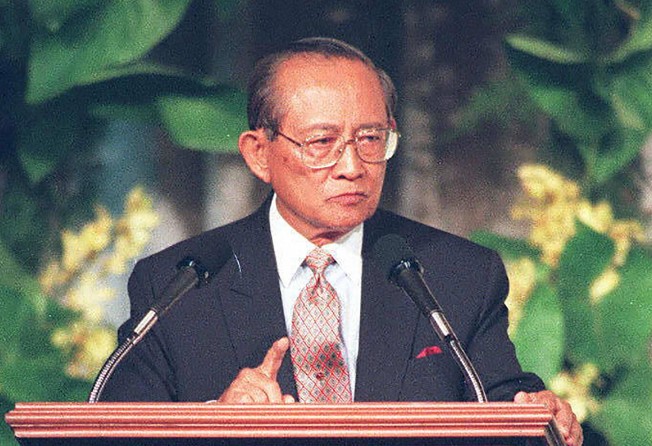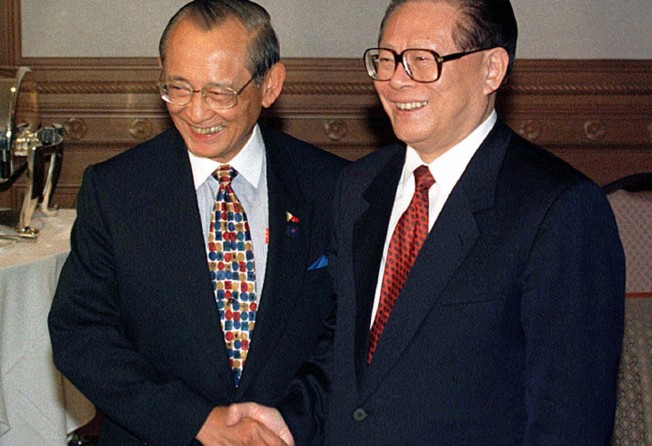
Philippines’ Fidel Ramos sought Beijing ties but also showed South China Sea defiance
- Ramos, who died on Sunday at the age of 94, started a programme to modernise his country’s armed forces to better protect territories in disputed region while pursuing one-China policy
- During and after his tenure, former Philippine president’s public position on China shifted between acceptance and defiance

Fidel V. Ramos, the Philippines’ 12th president who died on Sunday of Covid-19 complications at the age of 94, pursued a one-China policy during his tenure but also defied Beijing by starting a programme to modernise his country’s armed forces to better protect its territories in the disputed South China Sea.
When Ramos went on his only state visit to China in 1993, he reiterated the country’s one-China policy even though it was his late diplomat father Narciso who had opened an embassy in Taipei in 1965 and served as its ambassador till 1968.
The one-China policy was put in place by his second cousin, dictator Ferdinand Marcos Snr, in 1975 to stop the flow of arms and funds from China to local communist rebels.
President Corazon Aquino, who replaced Marcos Snr in 1987, continued the one-China policy and so did Ramos, when he said in Beijing in 1993: “We recognise the People’s Republic of China as the sole legitimate government of China and acknowledge the position of all Chinese, that there is only one China …”.
Two years later, however, relations soured as Ramos accused Beijing of militarising Mischief Reef which was within the country’s exclusive economic zone (EEZ).
Among all Philippine presidents, Ramos was well-placed to call on the United States for help, but a series of unfortunate events prevented that. Ramos was one of the few Filipino graduates of the United States Military Academy at West Point, fighting alongside American soldiers in the Korean war.
By the time he became president, however, the US had abandoned its army bases in the Philippines – even pulling out toilet bowls in the barracks – after the Philippine Senate refused to extend American presence over a disagreement on “rent”.
Ironically, it was Ramos’ diplomat-father who had signed an agreement with US State Secretary Dean Rusk in 1966 that cut the 1947 Military Bases Accord from 100 years to only 25 years, causing the agreement to lapse in 1991 instead of 2046.

Antonio Carpio, who was Ramos’ chief presidential legal counsel during the Mischief Reef stand-off, said on Monday that the US Department of Foreign Affairs “protested to China” and then “brought the issue to Asean, and this eventually led years later to the signing of the Declaration of Conduct between Asean and China”.
According to the memoir of Ramos’ then national security adviser General Jose Almonte, China’s occupation of Mischief Reef made Ramos realise the need to modernise the armed forces and turn to the only weapon Manila had at that time, which was “world opinion”.
Lacking a naval flotilla to respond with, the Ramos government instead sent to the reef the rickety World War II vintage navy amphibious assault craft BRP Benguet brimming with foreign and local journalists, Almonte recalled.
The former adviser said he and Carpio then hatched a plan to install lighthouses on Scarborough Shoal, which they felt China had designs on, but then Foreign Secretary Domingo Siazon – whom Almonte claimed was eyeing to become United Nations secretary general and therefore needed China’s backing – convinced Ramos to scuttle the plan because it would make China “angry”.
“Why FVR [Ramos’ nickname] listened to Siazon is a mystery to me,” Carpio said. “Probably FVR did not fully appreciate the extent of China’s plan in the West Philippine Sea.”

In the ensuing years, Ramos shifted his public position towards China from acceptance to defiance and back again. In 2001, he and two other former foreign heads of state formed the Boao Forum for Asia with a bid to encourage “China’s peaceful rise”.
Ramos spoke at an “Understanding 21st Century China” forum in 2014, a year after the Philippines filed an arbitration case against China over its “nine-dash line” claiming nearly all of the South China Sea. He stressed the need for good relations with Beijing and warned against war and nuclear cataclysm erupting over the South China Sea.
In 2016, weeks after Manila obtained a historic victory when the Permanent Court of Arbitration in The Hague nullified China’s nine-dash line claim over the South China Sea, Ramos flew to Hong Kong to become Rodrigo Duterte’s “special envoy” to China for one reason.
Because “China rejected the (arbitral) ruling, and an icy chill overcame the once-friendly bilateral relationship. It is time to bring back some warmth”, Ramos said.
But two months later, during another trip to Hong Kong, Ramos stopped being Duterte’s envoy. He lambasted Duterte for telling US President Barack Obama to “go to hell” and threatening to break up military relations with Washington after Obama had criticised his brutal war on drugs.
In his life, Ramos mastered the art of changing his mind at the right moment, with mixed consequences. As a cousin of Marcos Snr, he was in the inner circle that plotted the imposition of martial law which lasted 14 years, during which he was in charge of all detention camps and the Philippine Constabulary, one of the most brutal units in the armed forces.
Threatened by Marcos Snr with an arrest in 1986, he broke away and unwittingly triggered the peaceful uprising along EDSA, a highway around capital Manila, when people from all walks of life converged to protect him and defence minister Juan Ponce Enrile.
For decades, Ramos kept quiet on his role in the abuses during martial law, but in 2016 when Marcos Snr’s eldest daughter Imee chided him for committing those abuses, Ramos broke his silence and said his role in Edsa was “my atonement” for his martial law role.
Ramos also lambasted Duterte for giving the late dictator a hero’s burial at the Cemetery for Heroes. Yet it was he who had allowed the body to be returned from Hawaii.
Historian Jose Antonio Custodio said he considered Ramos the third-best post WWII president due to several corruption allegations marring the last part of his term.
Carpio, a retired magistrate, said Ramos’ legacy included solving a debilitating energy crisis inherited from Marcos, and liberalising the telecommunications, shipping, banking and civil aviation sectors. He also built key infrastructure such as a mass rail transit, formed special economic zones, and signed a peace deal with the rebel Moro National Liberation Front.
Even before Ramos ran for president in 1992, his biographer Apolinario Lozada wrote how “Steady Eddie” – as he was called – bided his time to fulfil his elders’ prophecy: “When Fidel V. Ramos was born on March 18, 1928, his umbilical cord was coiled around his neck in what old folks say is a rare sign of luck and great responsibility lying ahead.”